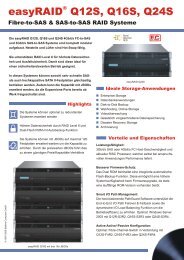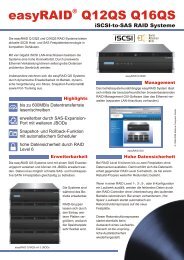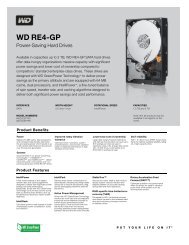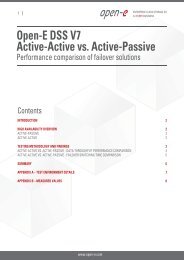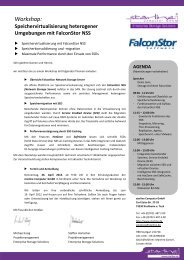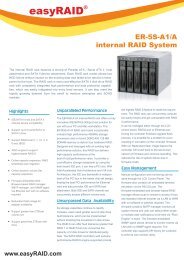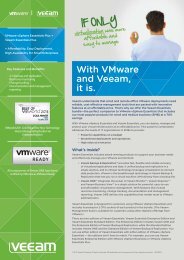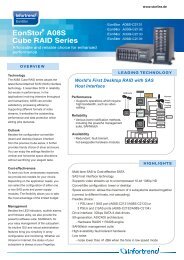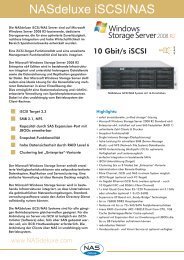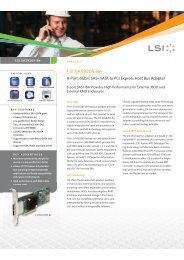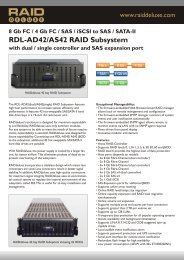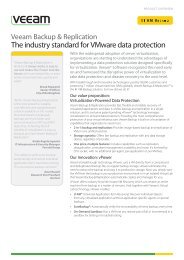TopRAID M100, powered by NEC, Datasheet (PDF)
TopRAID M100, powered by NEC, Datasheet (PDF)
TopRAID M100, powered by NEC, Datasheet (PDF)
Create successful ePaper yourself
Turn your PDF publications into a flip-book with our unique Google optimized e-Paper software.
<strong>TopRAID</strong> M Series Storage Systems<br />
For high performance and virtual environments,<br />
<strong>powered</strong> <strong>by</strong> <strong>NEC</strong>
<strong>TopRAID</strong> M Series Storage Systems<br />
For high performance and virtual environments, <strong>powered</strong> <strong>by</strong><br />
Key Features at a glance<br />
High Performance & High<br />
Availability<br />
• Super-Phoenix for cold restart and<br />
diagnosis for single HDDs<br />
• Advanced dynamic pool, expanding<br />
the capacity and performance<br />
simply <strong>by</strong> adding HDD<br />
• Firmwareupdates without downtime<br />
• Supports Self-encrypting drives<br />
• ANSI T10 DIF (512Byte data and<br />
8Byte CRC)<br />
Easy Installation & Operation<br />
• Thin Provisioning, Snapshots,<br />
In-Box-Replication inclusive<br />
• optional: Local- and Remote-<br />
Copy (via GUI/CLI),<br />
performance monitor, WORM<br />
• VMware ESXi 5.1/5.0/4.1<br />
certified, vCenter plugin,<br />
VAAI-Support<br />
• FalconStor NSS V7certified<br />
(<strong>M100</strong> and M300 with FC host)<br />
IT Cost Optimization<br />
• Bundeled management software<br />
with <strong>TopRAID</strong> <strong>M100</strong><br />
• Management workload can be<br />
reduced with virtualized system<br />
operations<br />
• Eco-friendly red. 80+ Gold PSU<br />
• MAID function<br />
Extreme Performance<br />
Page 2<br />
<strong>M100</strong><br />
Max. 8 ports<br />
(FC/iSCSI/SAS)<br />
Max. 96 HDDs<br />
M300<br />
Max. 8 ports<br />
(FC/iSCSI/SAS)<br />
Max. 144 HDDs<br />
Responding to ballooning data, preparing for virtualization and cloud environments, and<br />
responding to environmental and power-saving needs. The drastically changing environment<br />
of IT infrastructure requires a storage unit that meets these needs. M Series has been developed<br />
to satisfy these needs <strong>by</strong> bringing together the high reliability technology and innovative<br />
ability of <strong>NEC</strong>. The new SAN storage infrastructure leads the ever-evolving virtualization and<br />
cloud computing age.<br />
<strong>TopRAID</strong> M Series has superior characteristics for next-generation SAN storage units. These<br />
features address the need for high performance and high availability to support business continuity,<br />
advanced eco-friendly performance, easy installation and operations that reduce the<br />
management workload and economic efficiency that reduces the TCO to store and archive<br />
data.<br />
M Series offers a product lineup consisting of basic model <strong>M100</strong> Disk Array and high performance<br />
model M300 Disk Array that achieves a scaleable storage integration <strong>by</strong> utilizing<br />
advanced virtualization technologies such as data allocation optimization with a high-speed<br />
Solid State Drive (SSD) and Thin Provisioning, all developed to respond to the needs of the next<br />
generation.<br />
Demands on Storage Units<br />
• Reduce the workload required for storage management <strong>by</strong> using virtualization technology<br />
• Efficiently manage data according to its usage frequency<br />
• Dramatically reduce the power consumption of storage units for environmental<br />
conservation and power saving<br />
• Ensure the continuous operations in the face of unforeseen failures<br />
• Reduce the cost of storing ever-increasing data at businesses<br />
• Improve the operating efficiency <strong>by</strong> integrating a server virtualization environment<br />
• Construct a disaster response site to prepare for earthquakes and fires<br />
• Improve problematic backup systems<br />
www.<strong>TopRAID</strong>.com<br />
<strong>TopRAID</strong> <strong>M100</strong>/M300 Series is certified for<br />
VMware ESXi 5.1 and FalconStor NSS V7*<br />
(* supportet Fibre Channel host)<br />
NSS Version 7<br />
<strong>TopRAID</strong> M 100/M300 Series with 24 x 2.5 SFF and 12 x 3.5 LFF drive bays
Innovate virtualization with <strong>TopRAID</strong> M Series<br />
Advanced dynamic pool, expanding the capacity and<br />
performance simply <strong>by</strong> adding HDD<br />
The flexibility to respond to a sudden increase in data is vital in this age of<br />
constant change. <strong>TopRAID</strong> M Series offers an advanced dynamic pool that<br />
was recently developed <strong>by</strong> elevating the level of existing virtual pools. The<br />
advanced dynamic pool enables the automatic increase in pool capacity<br />
during capacity shortages simply <strong>by</strong> adding HDD, and improved<br />
performance of the entire pool <strong>by</strong> automatically optimizing data allocation<br />
to distribute data.<br />
<strong>M100</strong> M300<br />
Thin Provisioning, optimally allocating storage capacity in<br />
a virtualized environment<br />
The Thin Provisioning feature virtually allocates the capacity of a physical<br />
volume to a logical volume and adds HDD when the capacity of physical<br />
volume is insufficient. The storage usage is maximized because you can<br />
minimize the difference between the used space and the physical volume<br />
capacity. The initial investment cost and power consumption can also be<br />
reduced. In addition, it is not necessary to stop operations or adjust a<br />
schedule to change the capacity because HDD can be added without<br />
stopping jobs.<br />
<strong>M100</strong> M300<br />
Automatically allocating data to a suitable device<br />
according to access frequency<br />
M Series enables the creation of layers of different types of devices such as<br />
SSD that allows high-speed data access, high-performance SAS HDD, and<br />
high-capacity and low bit-cost nearline SAS HDD. The stored data is<br />
automatically re-allocated in suitable storage layers <strong>by</strong> routine monitoring<br />
so that frequently accessed data is moved to a SSD pool and infrequently<br />
accessed data is moved to a nearline SAS pool. This maximizes storage<br />
performance and optimizes the investment cost of the storage units.<br />
M300<br />
SSD L2 cache & persistent write, ensuring stable, highspeed<br />
performance<br />
M Series was developed to achieve higher levels of performance through<br />
utilization of SSD. The throughput of frequently accessed data was<br />
improved to remove hot spots <strong>by</strong> using SSD, which has a readout<br />
performance of superior speed, as an L2 cache. In addition, a persistent<br />
write cache can continue FastWrite operations <strong>by</strong> storing redundant data<br />
in SSD when an error occurs in one controller.<br />
M300<br />
Capacity recognized<br />
as LUN:10TB<br />
Add hard disk<br />
drives as<br />
required<br />
HDD<br />
Automatically allocating the<br />
stored data to a suitable<br />
device according to access<br />
frequency<br />
High<br />
Cost<br />
Low<br />
High<br />
Performance<br />
Low<br />
Persistent write<br />
Continuing FastWrite operations <strong>by</strong><br />
maintaining redundant data when an<br />
error occurs in one controller<br />
www.<strong>TopRAID</strong>.com<br />
HDD<br />
Add an HDD<br />
Logical disk<br />
Virtual capacity:10TB<br />
Actual<br />
capacity:5TB<br />
HDD<br />
Add an HDD<br />
Advanced dynamic pool<br />
HDD HDD HDD HDD HDD<br />
Application server<br />
Assign actual capacity<br />
when data is written<br />
Pool capacity:<br />
15TB<br />
Application server Application server<br />
Application server<br />
Write<br />
Free:10TB<br />
Used:5TB<br />
read<br />
Controller Controller<br />
Storage performance<br />
Threshold<br />
value:<br />
13TB<br />
SSD<br />
Workload<br />
Assigned capacity<br />
monitoring<br />
Management<br />
server<br />
Improving the operating efficiency of a server virtualization envionment <strong>by</strong> integrating with a VMware environment<br />
Storage<br />
Manager<br />
<strong>TopRAID</strong> M Series<br />
SSD pool<br />
SAS pool<br />
Nearline SAS pool<br />
<strong>TopRAID</strong> M Series<br />
SSD L2 cache<br />
Number of<br />
HDDs<br />
30<br />
20<br />
10<br />
Assignment<br />
history<br />
accumulation<br />
and analysis<br />
M Series supports VMware vStorage APIs for Array Integration (VAAI), a storage API provided <strong>by</strong> VMware, Inc. <strong>by</strong> incorporating this API, operations<br />
that were processed on a server in the past can be processed on the M Series product itself. These operations include the replication and migration of<br />
virtual machines, initialization of new virtual machines, and exclusive control of storage areas. Performing these operations enhances the operational<br />
efficiency of the entire virtualization environment, and increases overall performance.<br />
<strong>M100</strong> M300<br />
Removing hot spots <strong>by</strong> storing<br />
frequently accessed data in a<br />
SSD<br />
Page 3
Innovate business continuity with <strong>TopRAID</strong> M Series<br />
Enables the migration of data between storage units<br />
The data migration function responds to requests to move data from an<br />
existing storage unit to the M Series unit. Even when models do not support<br />
RDR, data can be moved economically without using an FC switch or other<br />
hardware.<br />
<strong>M100</strong> M300<br />
Migrate data between storage units<br />
(transferring from an existing storage unit)<br />
Application<br />
server<br />
RAID protects against double failures, handling increasing data capacities<br />
Replica<br />
SAN<br />
Source<br />
Existing disk array<br />
Destination<br />
<strong>TopRAID</strong> M Series<br />
Low-cost remote replication<br />
without an FC-IP converter<br />
Public line<br />
Migrates data <strong>by</strong><br />
copying the data<br />
from one storage<br />
unit to another<br />
The HDD capacity is becoming larger as business information rapidly increases. There is also a risk of data loss because the second HDD can fail<br />
while recovering a damaged HDD. M Series supports triple mirror feature that achieves the high-speed performance of RAID-1 and the reliability of<br />
RAID-6 in addition to the double parity configuration of RAID-6, responding to demands for both large capacities and high reliability. M Series can<br />
maintain its performance during failures with its design that duplicates main components, establishing a level of reliability equivalent to high-end<br />
models of storage units.<br />
<strong>M100</strong> M300<br />
Innovate interoperability with <strong>TopRAID</strong> M Series<br />
Intuitive GUI allows even first-time users to easily manage<br />
the storage unit<br />
The storage capacity, disk load, and operational status of each<br />
component, such as a connected server, can be checked in a visual web<br />
browser window. Navigation windows show the methods for specifying the<br />
replication settings, changing the capacity, and responding to failures. The<br />
easy-to-understand GUI environment eliminates errors during operation.<br />
<strong>M100</strong> M300<br />
iSCSI RDR economically counters disaster through remote<br />
replication<br />
Constructing a backup site to protect valuable data against disasters such<br />
as earthquakes and fires can cost a great deal of money and resources.<br />
With M Series, an IP line is used with iSCSI, making an FC-IP converter<br />
unnecessary and enabling the development of cost-efficient disaster<br />
prevention and response measures. In addition, low-cost operation is<br />
possible due to a reduction of line cost.<br />
<strong>M100</strong> M300<br />
Page 4<br />
Main site Backup site<br />
FC or iSCSI iSCSI<br />
Master<br />
DDR<br />
<strong>TopRAID</strong> M Series<br />
www.<strong>TopRAID</strong>.com<br />
RDR<br />
iSCSI FC or iSCSI<br />
Replica<br />
DDR<br />
Replica<br />
<strong>TopRAID</strong> M Series
Green innovation with <strong>TopRAID</strong> M Series<br />
Reducing power consumption with advanced power saving technology<br />
To offer top-class eco-friendly storage units, M Series was developed <strong>by</strong> applying advanced energy saving technology so<br />
that its power consumption is significantly less than previous models. It promotes power saving of the entire storage unit <strong>by</strong><br />
incorporating a low-power processor as its CPU and enabling autonomous control. For the power supply, M Series<br />
employs the 80PLUS GOLD certified high-efficiency power supplies. In addition, M Series incorporates as many power<br />
saving components as possible, and achieves a significant reduction in the total number of components. M Series can be<br />
used in 40°C (104°F) environments, reducing the power consumed <strong>by</strong> air conditioning.<br />
<strong>M100</strong> M300<br />
Realizing low-power operations <strong>by</strong> visualization of power<br />
consumption and autonomous device control<br />
The power consumption of all M Series units in the same infrastructure<br />
environment can be managed with real-time visualizations. In addition,<br />
components such as CPU, fan and HDD can autonomously control power<br />
consumption based on storage unit usage, Energy efficient operations are<br />
promoted <strong>by</strong> reducing unnecessary power consumption as much as<br />
possible when the storage unit is idle.<br />
<strong>M100</strong> M300<br />
Saving power resources with the autonomous MAID<br />
function<br />
The larger the system is, the more power is consumed and the more the<br />
running cost is increased. M Series adopts MAID (Massive Array of Inactive<br />
Disks) technology to promote energy efficiency. For example, <strong>by</strong> managing<br />
a job schedule in pool units with dedicated software, the motor of a<br />
backup disk drive that is not being used is turned off to save power.<br />
<strong>M100</strong> M300<br />
Energy efficient operation <strong>by</strong> autonomous contol<br />
Application server<br />
When MAID technology has been adopted<br />
Business volume<br />
Backup volume<br />
Innovate security with <strong>TopRAID</strong> M Series<br />
Advanced security functions such as data encryption and<br />
personal information leakage prevention<br />
The security of storage units that store confidential business data is always<br />
threatened. M Series uses a Self-encrypting drive (SED) to encrypt data.<br />
This function prevents data leakage when the HDD is inappropriately<br />
removed, lost, stolen, or damaged. Furthermore, M Series features a<br />
variety of security functions, including restrictions on access to logical<br />
disks, audit of logs and other records, and prevention of erroneous<br />
operations.<br />
<strong>M100</strong> M300<br />
Power consumption(kwh) I/O count<br />
Time<br />
Authentication<br />
key<br />
Register authentication key<br />
M-Series<br />
Storage Manager<br />
Authentication<br />
Prevents data from<br />
being accessed if<br />
the authentication<br />
key does not match<br />
www.<strong>TopRAID</strong>.com<br />
Reduce power consumption<br />
depending on usage<br />
Autonomous<br />
control<br />
In use<br />
<strong>TopRAID</strong> M Series<br />
Copying<br />
In use Stopped<br />
Business volume<br />
Backup job<br />
ON<br />
Backup volume<br />
OFF ON<br />
OFF<br />
Encryption<br />
HDD<br />
Application server<br />
Encryption<br />
HDD<br />
Read<br />
&<br />
write<br />
Encryption<br />
HDD<br />
Visualization of power consumption<br />
Data to be written to or read from<br />
the HDD is not encrypted. Since<br />
there is no overhead due to data<br />
encryption, performance does<br />
not degrade. Data recorded in an<br />
encryption HDD is encrypted.<br />
Even if the HDD is removed<br />
without permission, the data<br />
in the HDD cannot be<br />
accessed without the correct<br />
authentication key. Since<br />
data in the HDD is encrypted,<br />
it is not possible to decrypt it.<br />
Removing the HDD without permission<br />
XXXXXX<br />
XXXXXX<br />
Page 5
<strong>M100</strong> technical specifications<br />
<strong>M100</strong><br />
Models TR<strong>M100</strong>-12 TR<strong>M100</strong>-24<br />
Chassis Structure Up to 7 (seven) 3.5 LFF/2.5 SFF Disk JBODs can be connected to the Disk Array<br />
under the condition that the total number of slots is 96 or less<br />
HDD slots in a chassis 12 x 3.5 LFF 24 x 2.5 SFF<br />
RAID controller Dual/Single<br />
Host Interface Fibre Channel (8 Gbps), iSCSI (1 Gbps or 10 Gbps), SAS (6 Gbps)<br />
Number of Host Port, dual Controller 8x Fibre Channel ; 8x SAS x4 ; 8x 10 GbE iSCSI<br />
Number of Host Port, single Controller 4x Fibre Channel ; 4x SAS x4 ; 2x 10 GbE iSCSI<br />
Cache Memory Capacity 4 GB per Controller<br />
Cache Memory Backup method Save to flash memory (with 5 years warranty)<br />
RAID level RAID 0, 1, 5, 6, 10, 50, 60, TM<br />
Drives Interface<br />
Drives Type/Capacity<br />
SAS (6 Gbps)<br />
- SAS HDD 300/450/600 (15,000 rpm) 300/450/600/900 GB (10,000 rpm)<br />
- Nearline SAS HDD 1/2/3 TB (7,200 rpm) 1 TB (7,200 rpm)<br />
- SAS SSD 400 GB 100 GB<br />
- Encryption SAS HDD<br />
(*1)<br />
Max. Storage Capacity<br />
600 GB (15,000 rpm) 600 GB (10,000 rpm)<br />
- SAS HDD 44.5 TB 68.0 TB<br />
- Nearline SAS HDD 226.5 TB 76.1 TB<br />
- SAS SSD 3.4 TB 836 GB<br />
- Encryption SAS HDD 44.5 TB 44.5 TB<br />
(*2)<br />
Number of Drives 3-96 3-96<br />
(*3)<br />
Support OS Windows, Linux, VMware<br />
Chassis Dimensions (w x d x h) 482.0 x 545.2 x 87.8 mm (2U, with front bezel)<br />
Weight Disk Array 31 kg or less<br />
Weight Disk JBOD 29 kg or less<br />
Power Requirements<br />
Power Consumption (Max. at 25 °C)<br />
AC100 – 240 V single phase 50/60 Hz (redundant Power Supply Unit)<br />
- Disk Array with SAS HDD 485 W / 400 W 485 W / 395 W<br />
- Disk Array withNearline SAS HDD 420 W / 335 W 450 W / 365 W<br />
- Disk JBOD with SAS HDD 315 W / 265 W 310 W / 260 W<br />
- Disk JBOD with Nearline SAS HDD 250 W / 200 W 275 W / 225 W<br />
Temperature Operating: 5 to 40 degrees Celsius (41 to 104 degrees Fahrenheit)<br />
Non-operating: -10 to 60 degrees Celsius (14 to 140 degrees Fahrenheit)<br />
Relative Humidity Operating : 10 to 80% RH<br />
Non-operating : 5 to 80% RH<br />
Warranty 3 years (optional 5 years)<br />
*1 : Calculated on “1 GB=1,024 TB,”1 TB=1,024 <strong>by</strong>tes” basis.<br />
*2 : Up to 12 SSD can be installed.<br />
*3 : There might be some restrictions on the OS when connected with disk arrays<br />
Page 6<br />
<strong>TopRAID</strong> M 100/M300 Series with dual Fibre Channel Controller<br />
www.<strong>TopRAID</strong>.com
M300 technical specifications<br />
M300<br />
Models TRM300-12 TRM300-24<br />
Chassis Structure Up to 7 (seven) 3.5 LFF/2.5 SFF JBODs can be connected to the Disk Array under the<br />
condition that the total number of slots is 96 (M300-12), 144 (M300-24)or less<br />
HDD slots in a chassis 12 x 3.5 LFF 24 x 2.5 SFF<br />
RAID controller Dual<br />
Host Interface Fibre Channel (8 Gbps), iSCSI (1 Gbps or 10 Gbps), SAS (6 Gbps)<br />
Number of Host Port 8x Fibre Channel ; 8x SAS x4 ; 4x 10 GbE iSCSI ; Hybrid (4x FC + 4x 1 GbE iSCSI)<br />
Cache Memory Capacity 8 GB or 16 GB (4 GB or 8 GB per controller)<br />
Cache Memory Backup method Save to flash memory (with 5 years warranty)<br />
RAID level RAID 0, 1, 5, 6, 10, 50, 60, TM<br />
Drives Interface<br />
Drives Type/Capacity<br />
SAS (6 Gbps)<br />
- SAS HDD 300/450/600 (15,000 rpm) 300/450/600/900 GB (10,000 rpm)<br />
- Nearline SAS HDD 1/2/3 TB (7,200 rpm) 1 TB (7,200 rpm)<br />
- SAS SSD 400 GB 100 GB<br />
- Encryption SAS HDD<br />
(*1)<br />
Max. Storage Capacity<br />
600 GB (15,000 rpm) 600 GB (10,000 rpm)<br />
- SAS HDD 44.5 TB 102.0 TB<br />
- Nearline SAS HDD 226.5 TB 114.2 TB<br />
- SAS SSD 3.4 TB 836 GB<br />
- Encryption SAS HDD 44.5 TB 66.7 TB<br />
(*2)<br />
Number of Drives 3-96 3-144<br />
(*3)<br />
Support OS Windows, Linux, VMware, HP-UX, AIX, Solaris<br />
Chassis Dimensions (w x d x h) 482.0 x 545.2 x 87.8 mm (2U, with front bezel)<br />
Weight Disk Array 31 kg or less<br />
Weight Disk JBOD 29 kg or less<br />
Power Requirements<br />
Power Consumption (Max. at 25 °C)<br />
AC100 – 240 V single phase 50/60 Hz (redundant Power Supply Unit)<br />
- Disk Array with SAS HDD 510 W / 420 W 505 W / 420 W<br />
- Disk Array withNearline SAS HDD 445 W / 360 W 470 W / 385 W<br />
- Disk JBOD with SAS HDD 315 W / 265 W 310 W / 260 W<br />
- Disk JBOD with Nearline SAS HDD 250 W / 200 W 275 W / 225 W<br />
Temperature Operating: 5 to 40 degrees Celsius (41 to 104 degrees Fahrenheit)<br />
Non-operating: -10 to 60 degrees Celsius (14 to 140 degrees Fahrenheit)<br />
Relative Humidity Operating : 10 to 80% RH<br />
Non-operating : 5 to 80% RH<br />
Warranty 3 years (optional 5 years)<br />
*1 : Calculated on “1 GB=1,024 TB,”1 TB=1,024 <strong>by</strong>tes” basis.<br />
*2 : Up to 12 SSD can be installed.<br />
*3 : There might be some restrictions on the OS when connected with disk arrays<br />
www.<strong>TopRAID</strong>.com<br />
Page 7
MAIN Software for <strong>TopRAID</strong> M Series Disk Arrays<br />
Software Product Name<br />
Device management<br />
<strong>M100</strong> M300 Description<br />
Manager yes<br />
*1<br />
yes Basic functions to enable integrated storage operations management<br />
Manager Integration Base yes<br />
*1<br />
yes Functions to achieve integrated storage operations <strong>by</strong> in collaboration<br />
with Sigma System Center<br />
Manager Suite<br />
Performance management<br />
yes Package product including both Manager and Manager Integration Base<br />
Performance Monitor yes yes Functions to monitor storage performance in real-time and accumulate<br />
monitoring data<br />
Performance Navigator yes yes Functions to streamline the analysis of storage performance data<br />
Performance Monitor Suite<br />
Replication management<br />
yes yes Package product including both Performance Monitor and Performance Navigator<br />
Replication Navigator Suite<br />
Storage control<br />
yes yes Functions to simplify the procedures for constructing a backup system<br />
of databases, file servers, and virtual machines.<br />
Base Product yes Basic functions to control storage<br />
Manager Express<br />
*2<br />
yes<br />
*1<br />
yes Basic functions to enable storage operations management<br />
Control Command<br />
Replication<br />
yes yes CLI functions to perform operations such as replication and data protection<br />
on an application Server<br />
Dynamic Data Replication<br />
*1 + 3<br />
yes yes Functions to create a fully replicated volume in the same storage unit<br />
Remote Data Replication<br />
*3<br />
yes yes Functions to create a fully replicated volume in a remote storage unit<br />
Remote Data Replication Asynchronous<br />
*3<br />
yes yes Functions to asynchronously create a fully replicated volume in a remote<br />
store unit <strong>by</strong> using a Iow-speed line<br />
Dynamic Snap Volume<br />
*1+5<br />
yes<br />
*5<br />
yes Functions to create a differential replicated volume<br />
Replication Control SQL Option yes yes Option to enable non-disruptive backup of Microsoft SQL Server<br />
Replication Control File System Option<br />
Resource control<br />
yes yes Option to enable non-disruptive backup of file systems.<br />
Virtual Cache Partitioning yes Functions to divide storage resources and manage the divided storage<br />
resources as virtual storage<br />
Thin Provisioning<br />
*2<br />
yes<br />
*1<br />
yes Fundions to enhance the capacily jsage efficieiicy <strong>by</strong> setting the virtual<br />
logical capacity and reduciiig the physical capacity to be allocated<br />
Power ConServer<br />
*2<br />
yes<br />
*1<br />
yes Functions to reduce the power consumption of a storage unit <strong>by</strong><br />
controlling the running and stopping of a HDD<br />
Perfor Optimizer yes Functions to optimize performance <strong>by</strong> distributing the volume load and<br />
changing physical volume allocations without stopping jobs<br />
Perfor Cache yes yes Functions to use a SSD as cache memory<br />
Data Migration yes yes Functions to migrate data from an existing storage unit to a new one<br />
Volume Protect<br />
High availability<br />
yes yes Functions to protect data from tampering and guarantee data integrity<br />
for each volume<br />
Path Manager yes yes Functions to automatically switch paths and distribute the I/O loads<br />
1: Bundled with Base Product<br />
2: Bundled with <strong>M100</strong><br />
3: Not supported <strong>by</strong> a single controller model<br />
4: Dynamic DataReplication Express is bundled for <strong>M100</strong><br />
5: Bundled with Dynamic Data Replication<br />
<strong>TopRAID</strong> is a registered trademark. All other brands and product names appearing in this document are<br />
trademarks or registered trademarks of their respective holders.<br />
The information contained in this document is subject to change without notice. V-2012-10-25<br />
Page 8<br />
www.<strong>TopRAID</strong>.com



